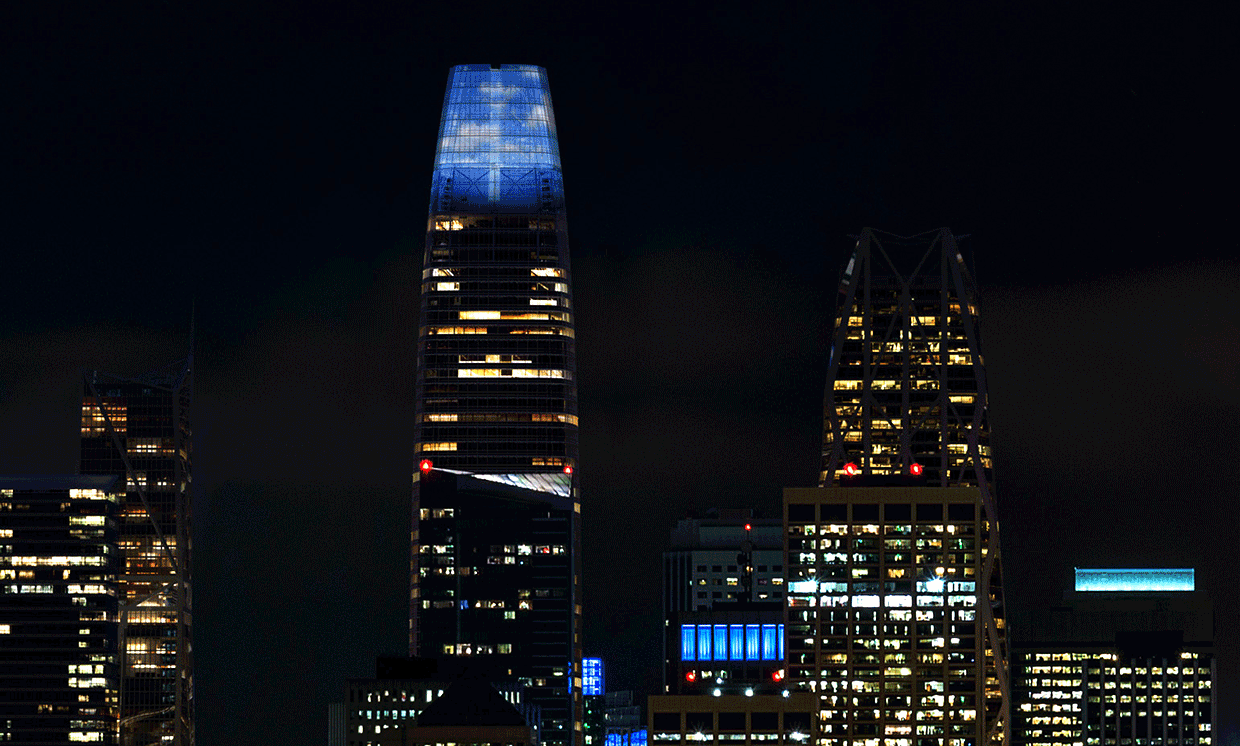Salesforce Tower, the new skyscraper dominating San Francisco’s skyline, lit up for the first time in April. That first show was just a test, but now, every night starting at dusk, silhouettes of dancers and other images move against a bright background across the façade of the top six floors of the 62-story building. The show is called “Day for Night,” and it goes on until 2 a.m.
For now, the tower remains dark for the rest of the night. But in a few months, another installation will light up, a three-dimensional starscape that will twinkle until dawn.
This approach is something new in skyscraper art, going far beyond the bands of colored lights that celebrate holidays and major events (such as the lights of the Empire State Building). And the Salesforce installation is thought to be the highest piece of public art in the world.
The creator of this dramatic display is Jim Campbell, an artist with works in nearly two dozen museums and installations around the world. Campbell is also an engineer, with dual degrees in electrical engineering and mathematics from MIT and more than 20 years of experience as adesign engineer at Faroudja Labs.
At Faroudja, Campbell first created analog circuitry and, later, digital algorithms to reduce noise and enhance the quality of video images. He collected, he recalls, between 15 and 20 patents. And while the Salesforce Tower project didn’t require him to use high-level algorithms, he still needed that engineering experience—and a lot of FPGAs—to pull it off.

Campbell was on a straightforward engineering track through most of college. Then, he recalls, “I realized I could get sucked into being an antisocial nerd, and started looking for balance.” He took some photograph and filmmaking classes—and liked it so much that he took a job in video production and spent a semester studying film in graduate school before settling into the job at Faroudja and working on art projects on the weekends.
He never stopped wanting to be more than a garage artist, however, and he approached galleries in San Francisco for years. Then, in 1988, he created a pop-up gallery himself, joining a friend to rent space in San Francisco’s Tenderloin neighborhood for a two-week exhibition. A curator for the San Francisco Museum of Modern Art (SFMOMA) came to the show and, with help from Gap founder Donald Fisher, acquired a piece for the museum. That work was “Hallucination,” an interactive video installation that visually set people on fire. SFMOMA put it on display in 1990.
More museum acquisitions by SFMOMA and others followed, but it still took a while before Campbell says he was comfortable calling himself an artist. He continued with his engineering job until 2009, though steadily dialed back the hours he spent at Faroudja.
Campbell loves both engineering and art, but says trying to make a career out of both felt “schizophrenic. The engineering and art parts of my brain are separate.” He even found himself using two names—Jack for his Silicon Valley career, Jim in the art world. At least then, when he got a phone call, he knew what the caller might be wanting. Finally, with a young child also demanding his time, he gave up the engineering job.
“That was a hard decision,” he says, “because I liked the engineering almost as much as the art. Most people would say, given the choice, ‘Of course you’ll choose art.’ But I do miss engineering.”
In addition to the Salesforce Tower, you can see Campbell’s work at the SFMOMA, which owns a number of pieces and is now showing one called “Tilted Plane.” Another piece, “Jacob’s Dram: A Luminous Light,” hangs from the ceiling of Grace Cathedral. Outside of San Francisco, his public art appears in the San Diego airport, in the Des Moines Civic Center, and in several other cities around the world.
Tekla S. Perry is a senior editor at IEEE Spectrum. Based in Palo Alto, Calif., she's been covering the people, companies, and technology that make Silicon Valley a special place for more than 40 years. An IEEE member, she holds a bachelor's degree in journalism from Michigan State University.



